On our canoe trip packing checklist, we list a “good book” as a camping essential and judging by how depleted the Paddlers’ Library in the Dining Hall was in midsummer, many of you agree.
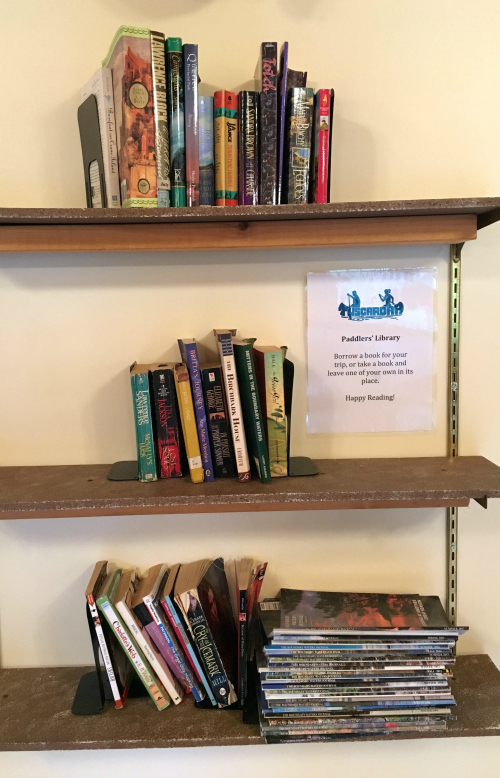
(Don’t worry, the shelves are looking a lot fuller these days, thanks to a delivery of books from the local Library Friends’ annual used book sale.)
As we watched all those books disappear this summer, we thought, “hey, you guys like reading . . . AND you like canoe trips, so maybe you’d enjoy some book recommendations about outdoor adventures.” With the lengthening nights, most of us are hanging up our lifejackets and picking up books, so hopefully these reading suggestions will help get you through the winter evenings until next summer’s paddling season.
Pre/Early Readers
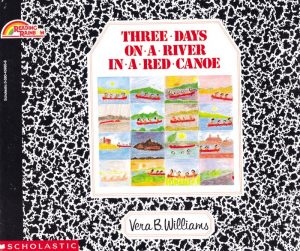
Three Days in a Red Canoe on a River, by Vera B. Williams
While this book definitely isn’t about a Boundary Waters trip (on day three, the group paddles through a town), I don’t know of a children’s book that does a better job of introducing overnight canoe camping to young children. Williams – who also authored the award-winning, A Chair for My Mother, along with other children’s literature classics – captures the excitement of picking up a canoe, plotting out a route on the maps, and discovering the perfect campsite. However, she also doesn’t shy away from some of the challenges of canoe camping, such as paddling through inclement weather and the real consequences of standing up in a moving canoe. The book’s sweet illustrations will charm readers of all ages. This book might just be the ticket to ease an apprehensive young camper’s worries about or pique interest in an upcoming canoe trip.
Young Readers
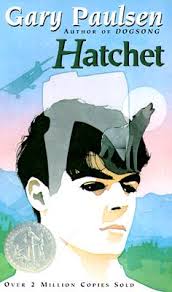
Hatchet, by Gary Paulsen
If you do have an apprehensive young camper, maybe don’t opt for Hatchet as read-aloud material before your next BWCAW trip. This “worst case scenario” young adult novel set deep in the Canadian bush follows Brian, a young teenager and sole survivor of a float plane crash. With little else than a hatchet, Brian proceeds to not only survive, but thrive in the deep wilderness, answering the question of many young visitors to the Boundary Waters and Quetico: what would it be like to live out here all by yourself? In the name of full disclosure, I will admit read this book when I was the target age for this book, somewhere between the ages of 8 – 12, and never reread it. At the time, I found the book fascinating, but realize now that Paulsen’s descriptions of a 13-year-old’s survival skills are probably pretty unrealistic. Paulsen’s subsequent sequels to Hatchet aren’t good, but if you’re willing to suspend disbelief, Hatchet is an enjoyable wilderness read.
Adult Readers
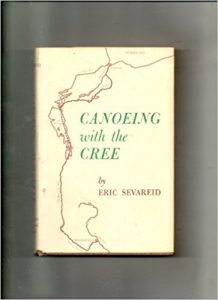
Canoeing with the Cree, by Eric Sevareid
The inspiration for many a canoe trip to Hudson Bay, Sevareid’s Canoeing with the Cree is perhaps the first great modern canoe trip memoir. In 1930, fresh out of high school, Sevareid and a friend embarked on a canoe trip from Minneapolis to York Factory, Ontario, Canada on Hudson Bay. Sevareid went on to be a notable war correspondent for CBS during World War II, and it’s easy to wonder if the grit he needed to be a successful war reporter stemmed from that four month, 2000+ mile canoe journey he took as a young man. Since its publication in 1935, Canoeing with the Cree has never gone out of print and in those 80+ years, at least two other books (and countless blog posts!) have been written about copy-cat canoe journeys.
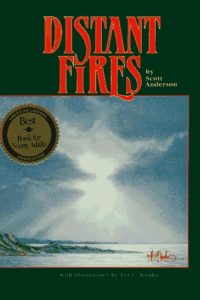
Distant Fires, by Scott D. Anderson
Perhaps the best known Canoeing with the Cree copycat journey is that taken by Scott D. Anderson in 1987, which he tells in his memoir, Distant Fires. While not an exact copy of Sevareid’s route (as a Duluth native, Anderson opted to start his journey in his hometown, effectively cutting about 500 miles from the route), Distant Fires is noted for its humor as it recounts the adventures of two college aged men sometimes working with, sometime working against Mother Nature on their three-month adventure. Sadly, Anderson died in 1999 at just 33 years of age, making Distant Fires a solemn reminder of how important it is to seize canoe trip opportunities in youth.
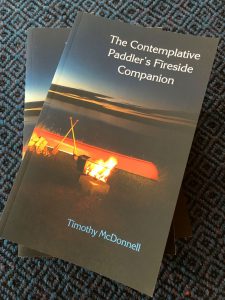
A Contemplative Paddler’s Fireside Companion, by Timothy McDonnell
McDonnell’s A Contemplative Paddler’s Fireside Companion offers an alternative to epic canoe trip memoirs like those produced by Sevareid and Anderson. Rather than recounting a single canoe trip odyssey, A Contemplative Paddler’s Fireside Companion is a collection of essays drawn from McDonnell’s cumulative experiences of canoeing and kayaking in the wilds of Canada and the upper Midwest. Forget the “veni, vidi, vici” bravado that can come with some wilderness memoirs. In this thoughtful tome, McDonnell get at the spiritual “why” of wilderness experience. And if the last name looks familiar, yes, we do refer to Timothy McDonnell more commonly as “Uncle Tim” around these parts.
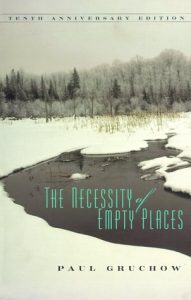
The Necessity of Empty Places, by Paul Gruchow
Andy recommends the work of Minnesota native Paul Gruchow, particular The Necessity of Empty Places in which Gruchow discusses the intrinsic value of the United States’ many wilderness landscapes. “If there is any cure this side of the grave,” Gruchow writes, “I am certain that it lies in the balm of nature.” If you’re looking for a more canoe trip focused read, Gruchow also authored Boundary Waters: The Grace of the Wild.

Wild, by Cheryl Strayed
Like it or not, it’s pretty hard to find a wilderness book with a female protagonist. While you’ve no doubt heard of Cheryl Strayed at some point in the last five years, if your only exposure to her is in passing pop culture references (I’m looking at you Gilmore Girls) or the Reese Witherspoon movie, I’d urge you to experience the actual book. Essentially a coming of age memoir, Strayed dabbles in many subjects in Wild including drug use, twenty-something career/life drift, and divorce at a young age, with the central theme being her coming to terms with the sudden loss of her mother to cancer at the very end of Strayed’s tumultuous childhood. For a book centered on a solo hiker on the Pacific Crest Trail, Wild is surprisingly focused on human interaction. Yet, it still captures the essence of a wilderness camping trip, from the tedium of camp food to the profound impact passing encounters with other individuals on the trail can have.
We’re curious: What are your favorite canoe trip/wilderness books?



I borrowed wild from my wife and read it. It was interesting and fun to see a rookie head into the wilderness. I’m sure Cheryl learned a lot about the wilderness and also about herself. It is still hard to beat a Jack Reacher novel.
I was given a copy of Distant Fires in the summer of 1993. I have read this book prior to each of my canoe trips ever since. With at least 30 trips since that gift it is a well read and beloved book.
Nice reading list! Not sure how I haven’t read Wild, considering I’m out and about so much… looks like it’s time to hit up Amazon. Thanks.